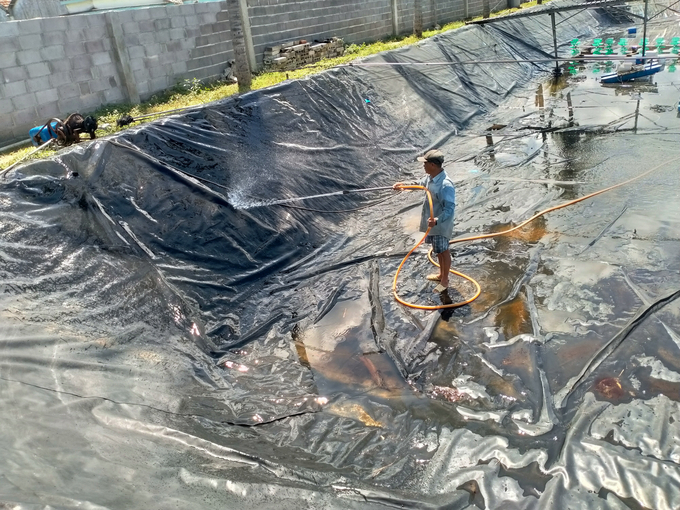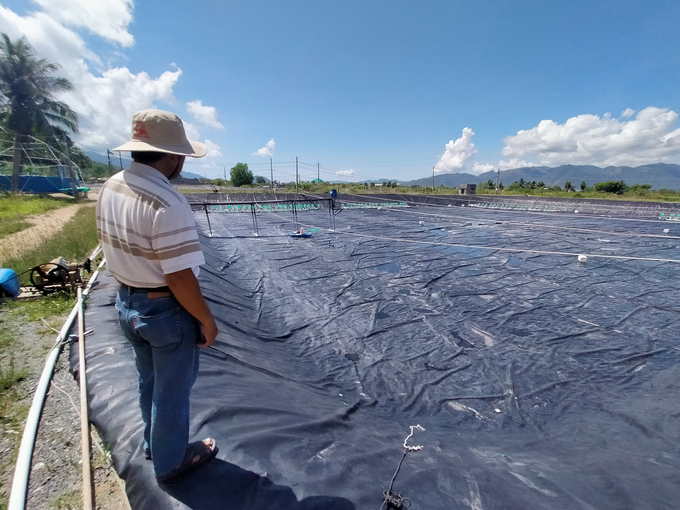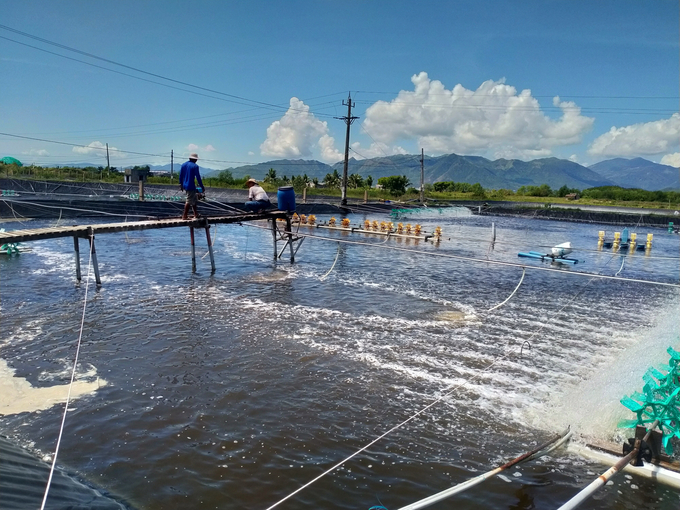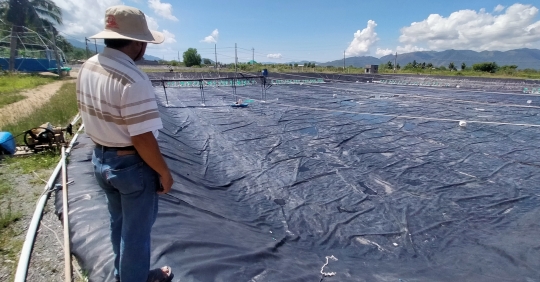Renovate the pond thoroughly
In order to smoothly start brackish shrimp farming in 2023, farmers in Khanh Hoa province are busy renovating ponds before stocking these days.
Mr. Le Minh Chinh, a white-leg shrimp farmer in Ninh Phu Township (Ninh Hoa City), said improving ponds before stocking is a very basic requirement for brackish water shrimp farming. If farmers improve their ponds well, they will limit the remaining pathogens in the previous crop. Along with the combination of measures to treat supply water, seed choice helps farmers reduce damage…

Shrimp ponds in Khanh Hoa focus on renovation to enter new breeding season. Photo: Kim So
According to Mr. Chinh, local shrimp farming is not favorable in the 2022 harvest, many ponds are suffering from EHP (sporozoite disease) as well as red body disease. It is therefore very important to improve the ponds before stocking them. Therefore, in the past, about 1.5 hectares of its covered ponds have been focused on sanitation and pathogen management.
“Currently, most of the farmers in the area have just renovated their ponds and nobody has much in stock yet because the windy and cold weather is hurting the shrimp farming. My family just released a breeding pond with about 1 million seeds for 10 days. They are expected to be released simultaneously after the January full moon,” Chinh said.
In the Vannamei shrimp plantation area in Van Tho township (Van Ninh district) covering an area of about 47 hectares, farmers have not yet survived due to the adverse weather. Mr Le Van Near, a shrimp farmer in Van Tho Municipality, said most farmers are focused on renovating their ponds and creating the necessary conditions for spring and summer sowing of the shrimp crop. Mr. Near’s family is also focused on renovating the pond to accommodate shrimp storage in early February.

Ponds are soaked in lime combined with caustic soda to kill bacteria and parasites. Photo: Kim So
According to shrimp farmers, the price of input materials for shrimp farming has increased. In particular, the price of shrimp feed has increased by about VND 3,000/kg compared to before. Specifically, the price of medium-sized feeds is around VND 600,000/bag, while high-protein feeds cost VND 700,000/bag (20kg type). In terms of white leg shrimp seeds, the supply is very plentiful, but the price is also up about 10% from the previous level, ranging from VND1.2-1.5 million/ten. While the price of commercial shrimp did not increase much, it ranged from 100 to 110,000 VND/kg (100 shrimp/kg).
Shrimp farmers must first register and declare
According to the assessment, the weather in our country in January-March 2023 tends to be warmer than in the same period in 2022.
In order to limit the impact of climate change on shrimp farming, reduce damage from natural disasters and epidemics, and ensure the brackish water shrimp farming plan in 2023, Mr. Le Tan Ban, director of the Ministry of Agriculture of Khanh Hoa and Rural Development: Hoa has a document recently sent to the coastal towns in the province to schedule the shrimp farming season.
Accordingly, the stocking density for black tiger shrimp farming from February to August 2023 is 15-25 shrimp/m2. In areas where intensive and semi-intensive farming is not possible, people should combine farming with biodiversity, such as B. black tiger shrimp with cobia, milkfish, mullet or tilapia, sea cucumber and seaweed … The time for stocking is from March to August The cultivation area has a good infrastructure and water sources, so that stocking can take place until the end of September.

Improving the pond is very important before the new harvest. Photo: Kim So
For breeding white-leg shrimp, the stocking period is from the second half of January to September 2023. In the case of tarpaulin-covered ponds (with a high stocking density of over 100 fish/m2), intensive and semi-intensive management methods should be used; or an earth pond with investments in modern facilities, equipment and new and advanced farming technology; Build a separate system of water supply and drainage ditches with ponds to treat sewage and sludge before releasing it to the outside environment.
In contrast, extensive farming, improved extensive farming, is applied to soil ponds with little investment in plant and equipment. Farmers can combine biodiversity like vannamei shrimp with tilapia in sedimentation ponds, shrimp with crab, etc.
Before storing shrimp for 5-10 days, the Ministry of Agriculture and Rural Development recommends that shrimp farmers monitor weather changes. If the weather is not favorable for farmed shrimp, discontinue stocking or contact the local aquaculture management agency. Also, it is necessary to inspect and test shrimp for dangerous diseases prior to introduction, including: MBV, WSSV, YHV, IHHNV, AHPND, and EHP.
In addition, farmers should maintain 2-3 instars and use large sized seed for commercial stocking; Added to this is the application of effective breeding models such as biotechnology, biofloc, recirculation, low water changes… and the further implementation of the chemical-restricted brackish water shrimp farming method.

Currently, scattered ponds in Khanh Hoa province have started storing shrimp seeds. Photo: Kim So
Agricultural households in the same area sharing the same water supply and drainage system should organize canal dredging to increase water supply and drainage capacity, while keeping shrimp in concentrated shrimp farming areas.
According to the regulation, no chemicals and antibiotics are prohibited during rearing. Especially the shrimp farming follows the plans, plans and guidelines of the local government for aquaculture and production. As well as the initial registration of notifications and the full and prompt implementation of measures to prevent and respond to natural disasters and epidemics under the guidance and direction of specialized agencies and local authorities.
Absolutely no dead shrimp carcasses, release untreated culture water into the environment; Measures to prevent waterborne illnesses must be strictly observed…
The agricultural sector of Khanh Hoa Province notes that for intensive and semi-intensive farming of black tiger shrimp, only one crop should be grown per year. There are also intensive, semi-intensive white leg shrimp and an improved extensive shrimp farm specializing in 2 harvests per year. During the breeding process, there should be a break between harvests of 1 month for effective ponds and 2 months for ponds damaged by disease or occupying other species such as sea bass, grouper, unisexual cichlid, kelp, sea cucumber, etc. to kill pathogens , increase income, improve environment.

